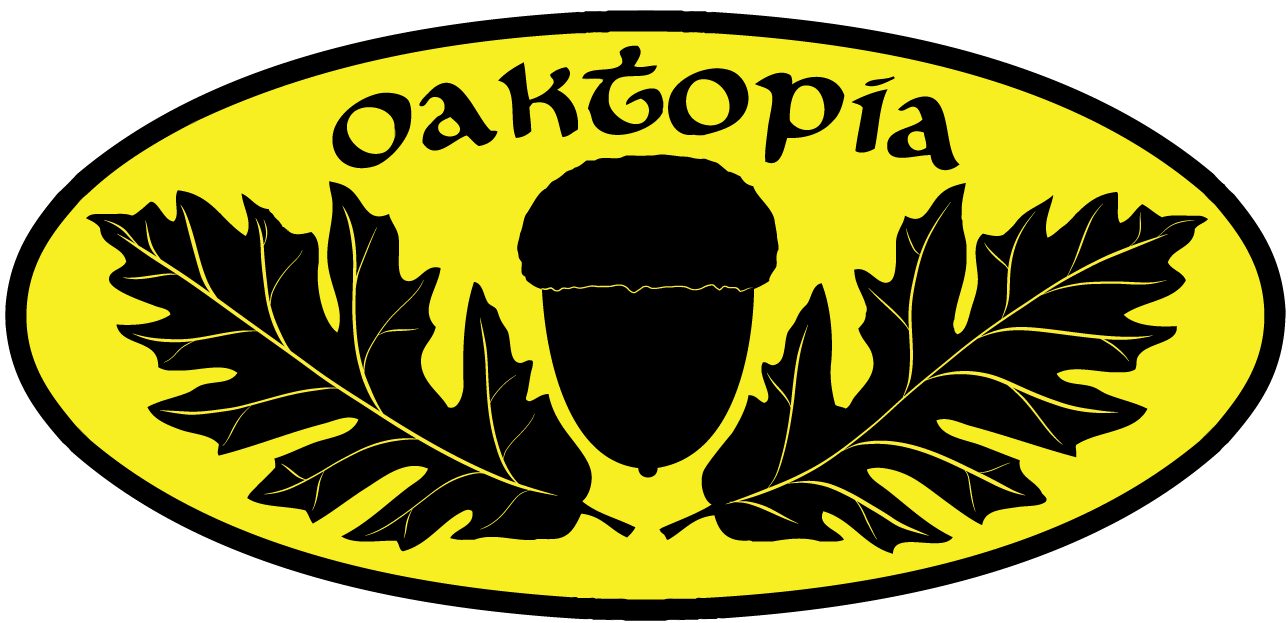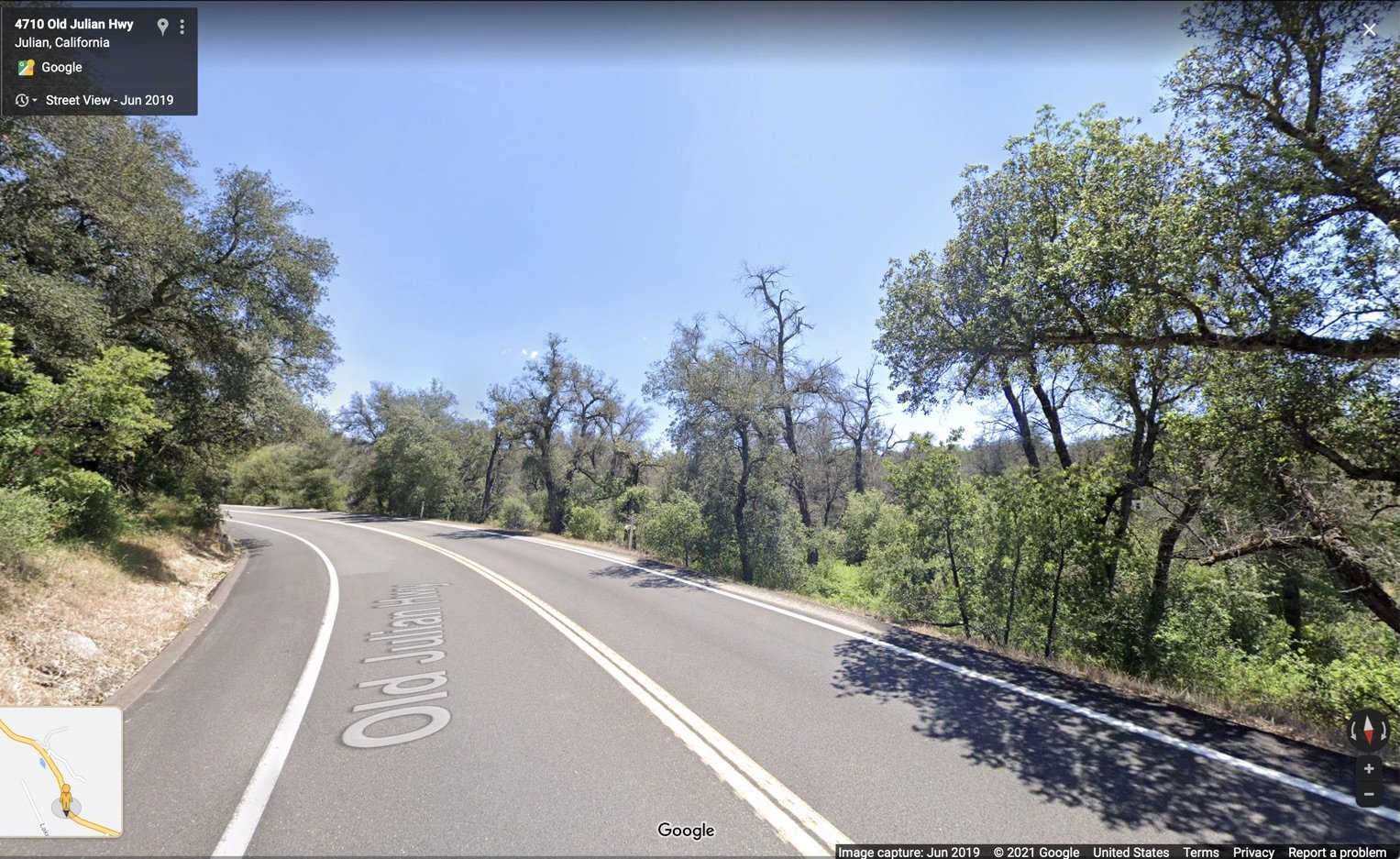The Road to Julian
Climate Change Winners and Losers in Coastal California Woodlands
Engelmann Oak Mast Year for 2019 - A Confluence of Factors
With demand increasing rapidly for California native climate change resilient tree species, we set out to assess the Engelmann Oak (Quercus Engelmannii) acorn crop for 2019. We started out in Descanso, headed toward Willow and the Reservation. We found a promising packed dirt road, and headed up looking for our bluish friends.
Given the rains and cool temperatures in the year, there was hope for a good crop. And, sure enough, our hopes proved realistic, as abundant crop was present on all the trees we looked at. Even though ripening is still 4 months away, only a series of brutal heat waves threaten the crop, and even that is unlikely to dissuade this year's Engelmann acorn mast.
There was an incredibly confluence of factors leading to this abundant crop. Almost certainly the most critical factor was our very strong rainy season. But when the rains fall is critical for acorn set, or pollination. If substantial rain falls during the time oak flowers and catkins are open, the pollen will wash away. No matter how good the rains have been, and how full of vigor the trees are, there can be no acorns without pollen meeting flower. The rains came on strong in the early to middle part of the season, and left a nice, long dry period for pollination to occur.
Then a final factor sealed the deal. After the acorns were set, there were some substantial spring rains in southern California, giving the trees a potent boost, right at the moment the tree is "deciding" how many of the set acorns it can carry to maturity in the fall. It is common to see small, barely-formed acorns drop in profusion shortly after acorn set. This is the tree "deciding" that it doesn't have sufficient excess stored energy to carry all the set acorns to maturity.
Looking at the Engelmann oaks this year, it appears those late rains, in concert with the earlier rains, convinced many an Engelmann oak to go ahead carry a crop. This is the definition of a mast year in oaks.
The Road to Julian
We knew there were additional Engelmanns in the area, up toward Ramona and Julian, and we were full of enthusiasm seeing the good crop thus far. But we were in for a shocking sight as we drove toward Julian. At first all we saw were more of the unusually healthy Engelmann oaks, with some Coast Live Oak (CLO) (Quercus agrifolia). But suddenly the scene changed. Acres of fully dead Coast Live Oaks (CLOs). Thousands and thousands of trees. Just a few miles up the road from where the Engelmann oaks are thriving!
Of further interest, the Black Oaks (Quercus kelloggii), look really good here, right in the areas with the dead CLOs. And then there's the Quercus x ganderi, the hybrid of CLO and Black Oak. They are thriving in the area where one of the parents is literally being driven to extinction! This appears evolution in action, with climate change offering the selection stress. The rise of a hybrid during the loss of one of the parent species seems textbook oak evolution.
Then I found more Engelmanns close to the ocean, in Orange County. San Juan Capistrano area.
I went to a park called Caspers, which I knew should be within the OC Engelmann range from calflora listings. I asked the seemingly bright and attentive woman at the front pay station who offered me maps if they had Engelmann oaks at the park. None that she had ever heard of there.
So I drive to the nature center, which was closed. Engelmann oaks next to the building!
Actually, a Quercus arizonica-type subspecies Engelmann, with a Quercus x cornelius-mulleri (Q. c-m) scrub oak, and a Quercus x acutidens, the intermediate between Engelmann Oak and Q. c-m. The whole evolution, right there. All lined up, like a science display. Literally next to the building. Rare native trees. No signage, and the staff doesn't even know they are there. Wow.
But the park is mostly upland semi-riparian flatland, and that was indeed 100% CLO among oaks. But there were some low hills, and you started seeing blue-green foliage maybe 100 feet up the hills. Those are Engelmanns. You can spot them along the Highway 74 once you tune into the coloration.
The more I look at Engelmann oaks in the field, the more I see that it isn't really a species, but it is a long-evolved hybrid swarm. But the types are highly distinct, and I think what we are really seeing are a small group of subspecies, rather than classifying them as the more subtly-different ecotypes.
In fact, I wonder if we be able to prove that the related Southwestern species actually exist in California - Quercus grisea, Quercus arizonica, Quercus oblongifolia. It might be possible that there are isolated pockets that got only one of the types, and the genotype has been able to continue as it would be found in the Southwest. If genetics could help prove that, it'd shake up California horticulture pretty good. But it's up to me to spot candidates in the field first, and perhaps they are all indeed too far intrograded to still exist as species.
But the road to the Julian led me to insights that stretch far beyond Engelmann oak range.
Coastal Oracle Oak (Quercus x ganderi)
What's now jumping out at me is the Quercus x ganderi hybrid is winning in these changing times.
I was recently consulting in Woodside - first in winter, then a month ago. When I visited the property in winter, I thought the trees we were looking at were CLOs. And they looked quite thin in the canopy.
Then I went back in late spring, and the trees were full of leaves. Very healthy, actually. I looked at a leaf. Oops. Hybrid. Quercus x ganderi. The reason the trees had looked thin was they are semi-evergreen!
I grabbed a leaf, and saw the Black Oak introgression.
As a final confirming trait, the trees in question are very tall - much taller and more upright in growth habit than regular CLO, which can indeed be found nearby, but downhill, and farther from the Black Oak parent. Black Oak is consistently an upright growing tree.
As I left, I realized that there was substantial dieback in true CLOs in the area, while the Quercus x ganderi looked good.
Then I realized an even more interesting pattern, this time human. The property I was on, a lovely large piece of Woodside, is next to an even lovelier and larger piece of Woodside, the controversial parcel once owned by Steve Jobs.
Steve had chosen to live in the midst or Quercus x ganderi when these hybrids only exist in very limited areas, even in the Woodside area. I later gained more evidence that, indeed, billionaires prefer Quercus x ganderi
But first I went 500 miles south and, again, Quercus x ganderi looking good at Julian, while CLO's were mostly dead and apparently extirpating from the area. It's a super striking pattern to see over a wide area, and should be documented.
Then last week, in Napa. Billionaire client with a lot of oaks, mostly CLO. On the first line of hills above Oakville, with the aboveground portion of the house framed in the arch of the Robert Mondavi winery.
Some of the clos on the property looked good, while others were weak with dieback. Then I looked closer. All the good looking trees had clear Black Oak introgression! There were certainly true Black Oak on the site, so these hybrids are inevitable.
Sure seems like Mama Nature is trying to tell me something.
Woodside. Napa. Julian. Santa Barbara. La Honda. Saratoga. Q. X ganderi is winning in varied locations throughout coastal California.
But even more confirmation awaited me.
Last Friday I went to Devil Mountain Nursery out by Lodi. They have nice looking clos in 24s. Upright, dark green, full foliage. I go look at the foliage. Clear lobing in the Black Oak pattern. Quercus x ganderi. They came from Cornflower Farms, a big wholesale native grower, in Sacramento. Known for above average and consistent quality. Good folks. Experienced seed pickers find the really healthy, fertile trees. And when you look through the CLO dominated woodland of California, it's the Quercus x ganderi forms that are winning where they are present.
Shreve Oak (Quercus parvula var. shreveii)
But what about the areas where CLO exists without any Black Oak nearby? There may still be some Quercus x ganderi types present, but epochs of introgression have diluted the hybrid status to the point where all the trees become similar, and then fall within the morphological range typical of CLO.
Some of these zones without Black Oak you get another rare wetter-rainfall native oak, the Shreve Oak, (Quercus parvula var. shreveii). These trees are more closely allied to the Interior Live Oak (Quercus wislizenii), than to CLO.
But Shreve Oak is its own distinctive being in the limited, higher rainfall areas where they grow. They can be identified by their modest stature - half the size of a typical CLO in many cases, but massive, ancient Shreve Oaks can be found, and one used to exist on the former property of the Yerba Buena Nursery in the Santa Cruz Mountains.
What is interesting to note is that in areas where Shreve Oak occurs with CLO, Shreve Oaks are thriving, while the CLO's, as we are seeing in varied locations throughout their range, and often in decline, or dead, from causes that seem to go well beyond the simple explanations of drought and Sudden Oak Death. There is something up with CLO in many places in their range, while related species and hybrids are thriving.
This appears the very model of evolutionary plant adaptation in times of rapid climate change. These patterns are being noted by seasoned observers throughout Coastal California, and these patterns mimic global patterns of mass tree decline/die-off, coupled with documented species movement.
More than 25 years ago, ecological researchers warned the world - without much heed from the world - that climate change would cause mass population changes and range shifts, and, indeed, these warning appear more prescient every day. Mass tree die-offs have been documented in the last 10 years from every continent except Antarctica.
This is a critical moment for surveillance of our forests, to watch for the shifts, and learn the message that is being offered to us. Shreve Oak appears to be winning in areas where CLO is losing, and there should be no surprise that such alterations in the ecological order are occurring, and only observation of the local manifestations of the vast and largely uncontrolled scientific experiment that is anthropogenic climate change.
Shreve oaks are lovely where they are adapted. They seem to stay within areas of high rainfall and particularly fast soil drainage in coastal California. You see them around Santa Cruz, up into the Santa Cruz Mountains, and south into the Santa Lucias down to Santa Barbara County.
Reports of Shreve Oak are listed in Calflora north into Mendocino, but it should be noted that some of the photos in Calflora are actually hybrids of Shreve Oak, typically with Coast Live Oak.
But what we are talking about in this writing is true Shreve Oak possessing single-pointed leaves with entire margins. Toothed leaf margins on a purported Shreve Oak likely indicates hybrid introgression, probably with CLO, but also possibly with both Interior Live Oak, and Black Oak, depending on their local presence.


